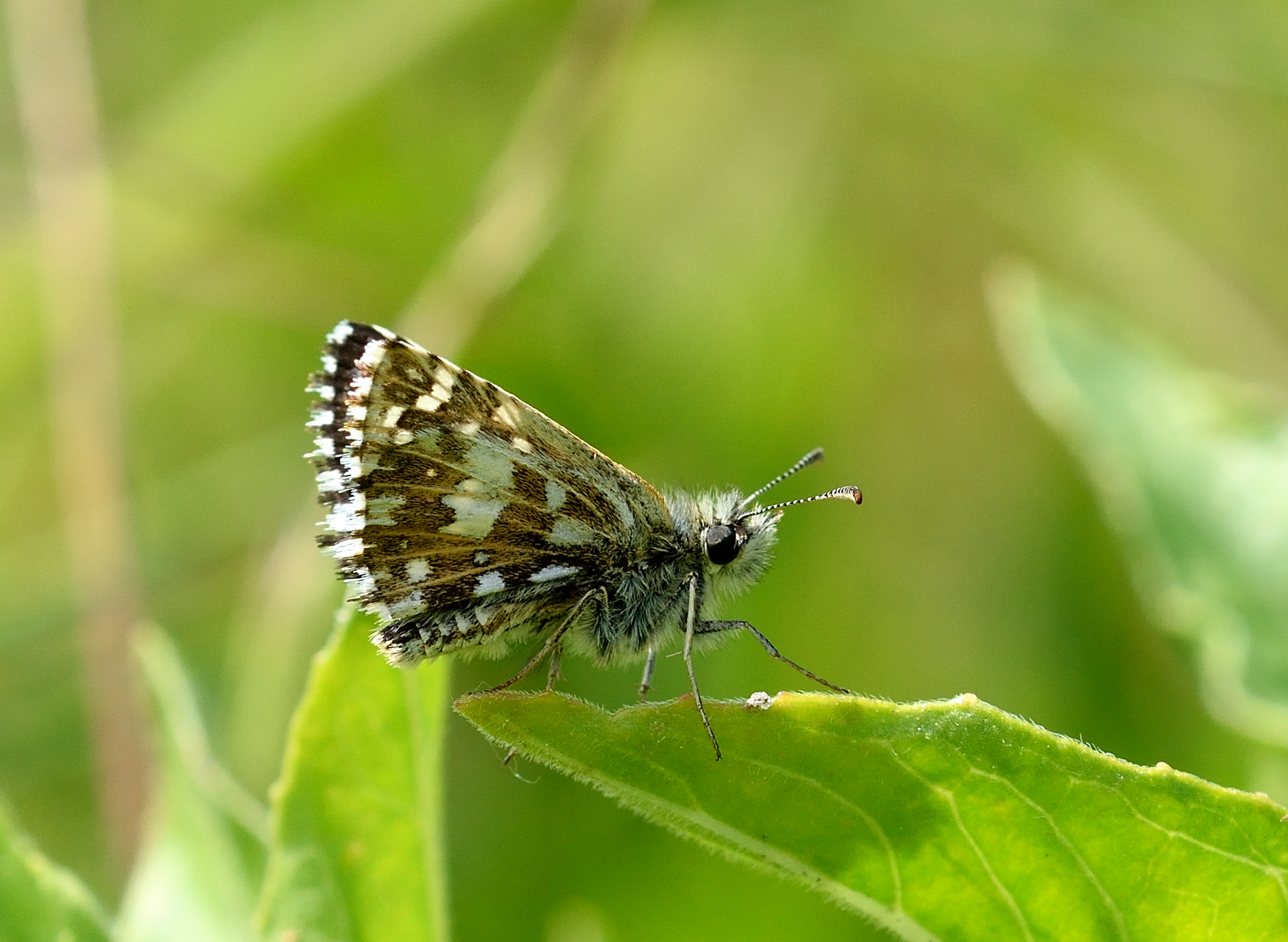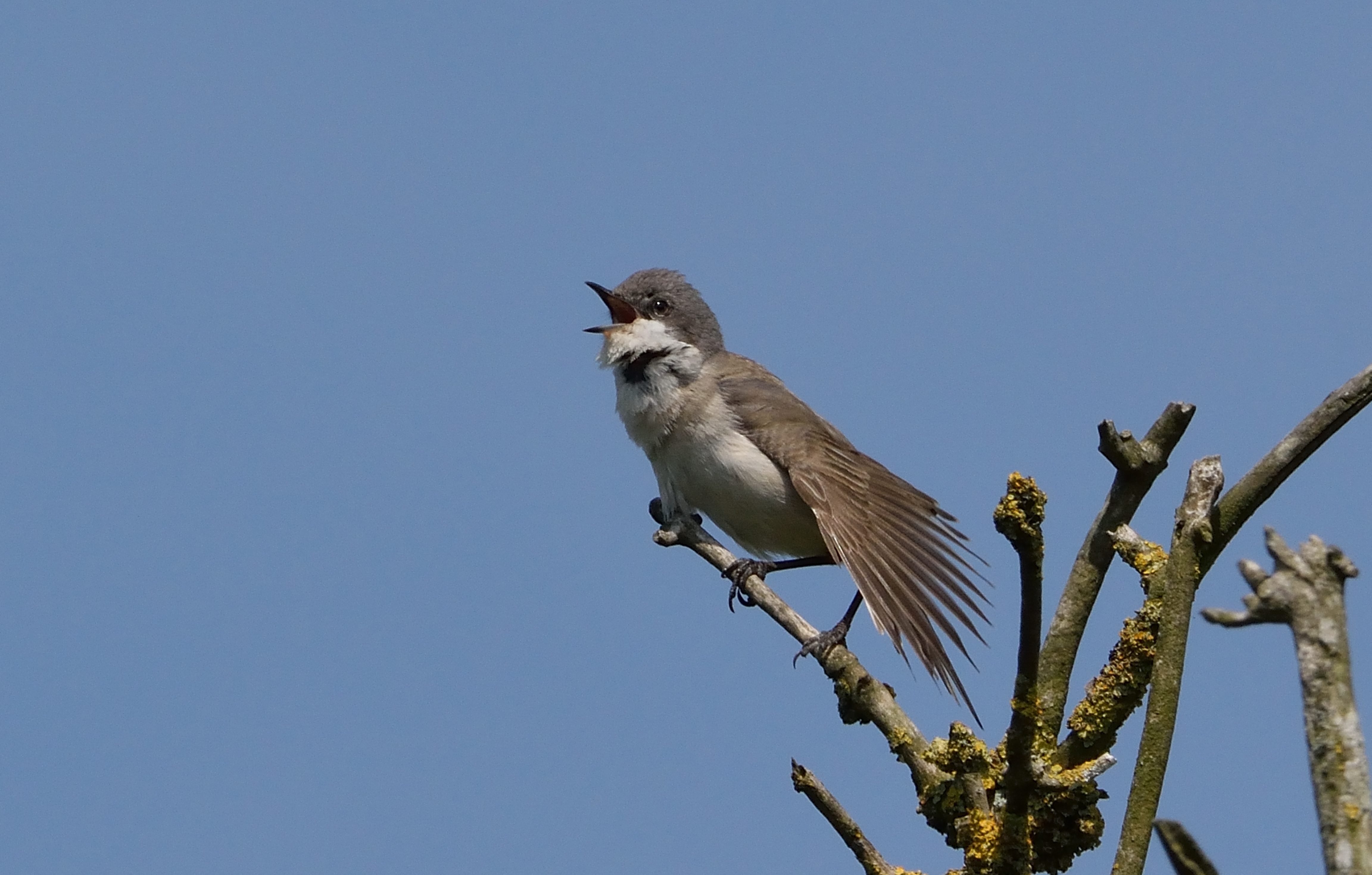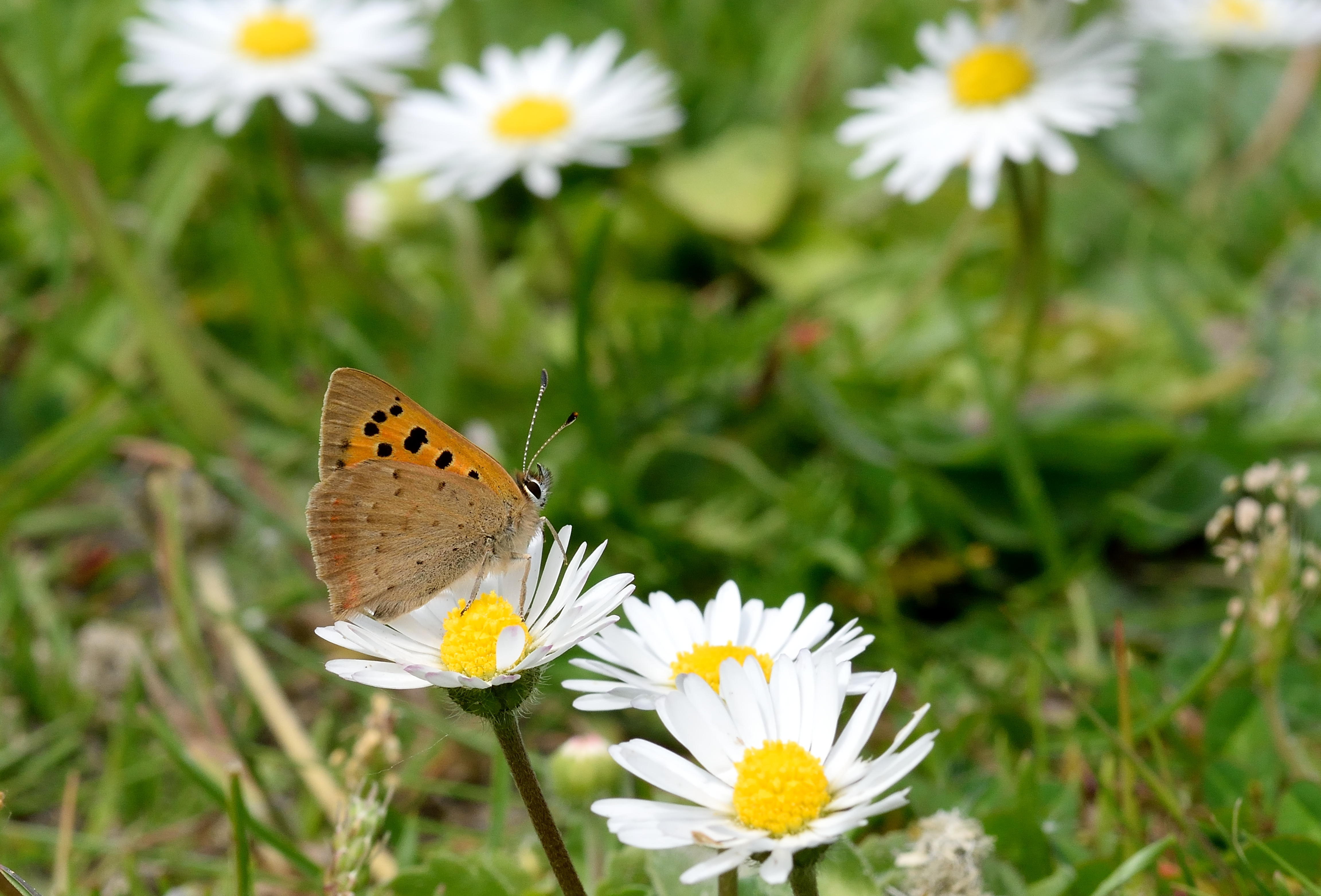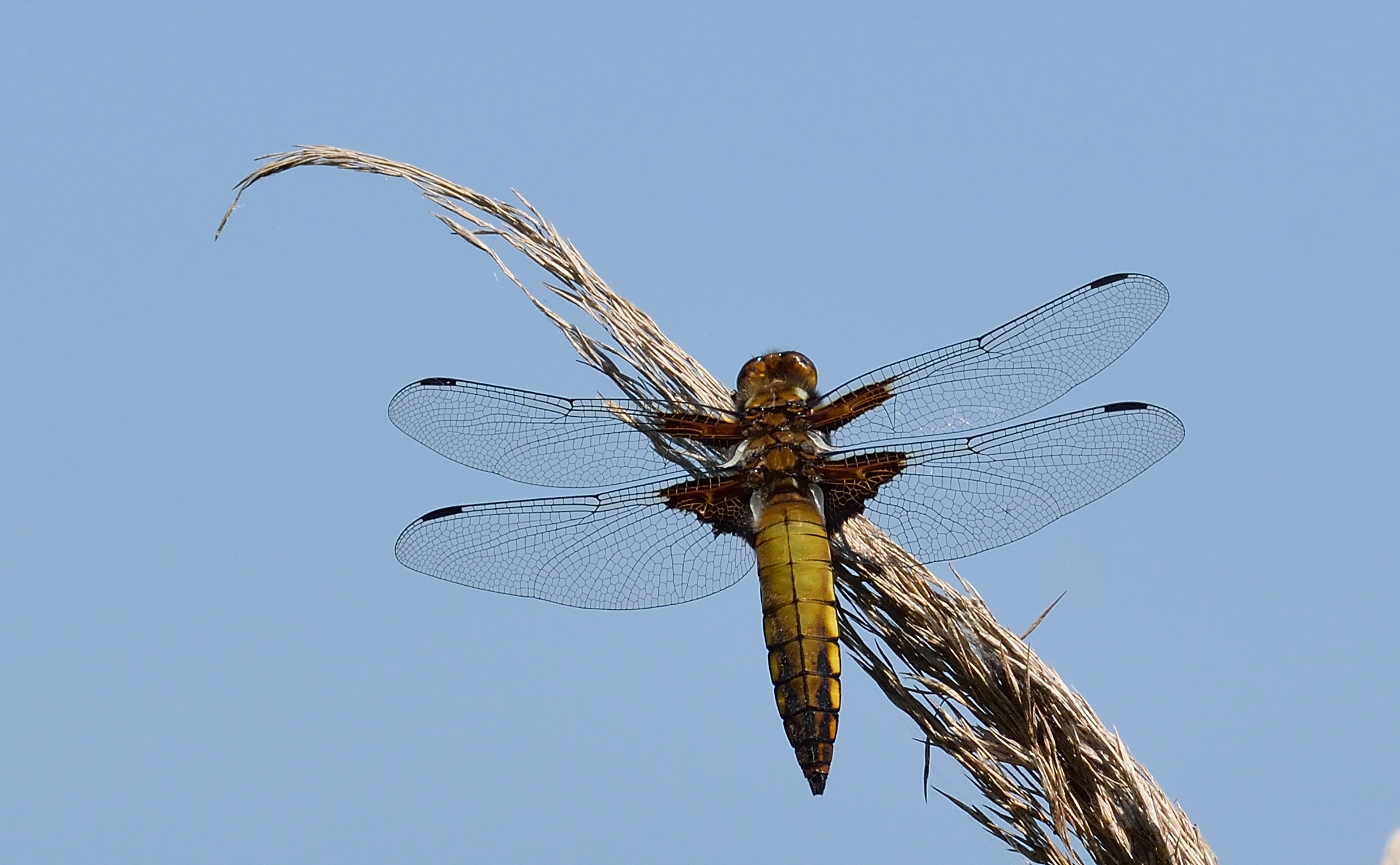With the lovely weather continuing into early May it was a good time to head out to another of my favourite spring sites, the Cut-off Channel at Stoke Ferry about 50 miles west. Arrived at the car park at the end of School Lane and instantly heard the ‘purring’ song of a Turtle Dove, a rare sound in the UK these days as their numbers have crashed in recent years. A pleasant walk along the high banking through the trees to the open area where the rare Grizzled Skipper (Pyrgus malvae) can be found, one of only two places in the County.


I photographed four Grizzles, when I checked the images they were differently marked so not a bad score. Another type of skipper was flying around as if fueled by an overdose of caffeine, this was slightly larger, a rather unfortunately named Dingy Skipper (Erynnis tages). Took a while before I managed a few half decent shots of this speed freak, the first I have seen at this site.


I had taken along the big zoom as well as the macro in the hope of photographing some bird life. In the event it only got used once when a Lesser Whitethroat (Sylvia curruca) obliged by singing from the top of a dead bush. This recently returned migrant from Africa is normally quite secretive only giving away it’s presence by the song which is best described as a rattle.



A great day in the wild west. Time to look closer to home. Would the sun bring out an early Swallowtail at Hickling? Only one way to find out, go look. Sadly not, but the dragonflies put on a good show. Not had one emerge from my garden pond this year only damselflies which is rather strange.

You may be thinking with all these images from my last two posts that everything is in abundance, sadly this is not the case. I have seen pretty much all the butterfly species I have expected but the numbers are depressingly low. Four different Grizzled Skippers is a great percentage for a Norfolk rarity but the ‘common’ butterflies are very scarce. We have now had the odd day or two of heavy rain, hopefully summer will kick on.

It’s nice you are able to catch the butters sitting still, for the most part.
LikeLiked by 1 person
They can be somewhat trying!
Thanks for looking Brad.
LikeLiked by 1 person
The images are lovely. I’ve seen one Yellow-Swallowtail flitting by my Hummingbird feeder already. I hope there are more, and your numbers come up.
LikeLiked by 1 person
Thank you Deborah. We need a good summer but a succession of poor springs has lowered the numbers of those early species.
LikeLiked by 1 person
Dragonflies are such amazing creatures. Beautiful photos, as always.
LikeLiked by 1 person
Thank you Rubens, got to love dragonflies.
Off to my first drag race of the season on Saturday so keep you eyes peeled for a future post.
LikeLiked by 1 person
I can’t get excited about Skippers I’m afraid (however rare) but I do love those 2 butterflies. I agree though that the butterfly numbers appear to be down. I’ve just spent 4 days wandering around Shropshire with my mates (posts to come -eventually) and I think I only captured two! (But then my mates don’t stop walking if I spot something so I get left way behind!)
LikeLiked by 1 person
Some parts of the country are doing ok Mike, just not where I live!
Look forward to your latest walks.
LikeLiked by 1 person
You really have a remarkable photographic talent, Brian.
I hope the insect life increases bountifully in the coming weeks, and I am intrigued by the decline in the turtle dove numbers you mention?
LikeLiked by 1 person
Thanks Dries. Some parts of the country some butterfly species are doing ok, where I live a very poor spring has had an effect. Even in my garden numbers of bees and hoverflies are very low compared to previous years and as I said (so far) no dragonflies.
The Turtle Dove is a pretty rare sight here now. They are shot in their thousands if not millions as they migrate through southern Europe in spring and autumn. Those that reach our shore find that agricultural changes over decades have removed nesting sites and areas where they fed on wild seeds. Conservation work is under way to try and reverse this by planting new hedgerows and re-instating field margins. The doves are also being bred in captivity but I fear it’s all too little, too late. If the hunting is stopped there may be a chance of an increased breeding population but until then the future is not bright.
LikeLiked by 1 person
What a sad state of affairs that is, Brian. Thanks for the explanation though!
LikeLiked by 1 person
Beautiful shot of that Grizzled Skipper! The birding world seems to be equally down this year – migration didn’t seem to pan out much so either they came and took off rather quickly or some decided to stay on the beaches and sip their umbrella drinks. What we are dealing with right now is the 17 yr Cicada emergence – now those are EVERYWHERE and DEAFENING. It might have annoyed the new comers and they just kept going.
LikeLiked by 1 person
Don’t have Cicadas here, do you get a few every year then millions on certain years? I read they live underground for 17 years which seems a pretty dull life.
Bird migration is a bit hit & miss, you need good fall conditions. Trouble with our spring butterflies is we have had a succession of poor springs so breeding chances are few and far between now numbers are at a low ebb.
LikeLiked by 1 person
There are always some about every year, but there is a burst around the 17 year mark that are deafening. There is a slightly smaller eruption every 13 years..no idea what the timing suggests, but eventually those two are going to line up and then look out ha.
LikeLike
Very nice work on the Grizzled Skippers. Not easy to get such quality with such a small subject.
I’m confident your summer will produce some great trips for you. Around here, odes are beginning to outnumber the mozzies and that is a very good thing.
Your shot of the Chaser looks like you may have been laying down and looking up. Great shot no matter how you did it.
LikeLiked by 1 person
Thank you Wally.
We have at least another week of rain ahead of us but yes I’m sure we will still make some nice days out.
With that Chaser no lying down, the reed was head high!
LikeLiked by 1 person
I love it when the perches and perchers make it more convenient!
LikeLike
It’s easy to see why this is one of your favourite sites to visit. I love your photos and am sad with you for the low numbers and species of insects. May we do what is necessary to help them recover!
LikeLiked by 1 person
We have had a succession of poor springs in this part of the country which has had a big impact. Other parts of the UK have fared better. What is needed is good weather at the right time of the year to allow species that appear in spring to recover.
LikeLiked by 1 person
I’m crossing all my fingers . . .
LikeLike